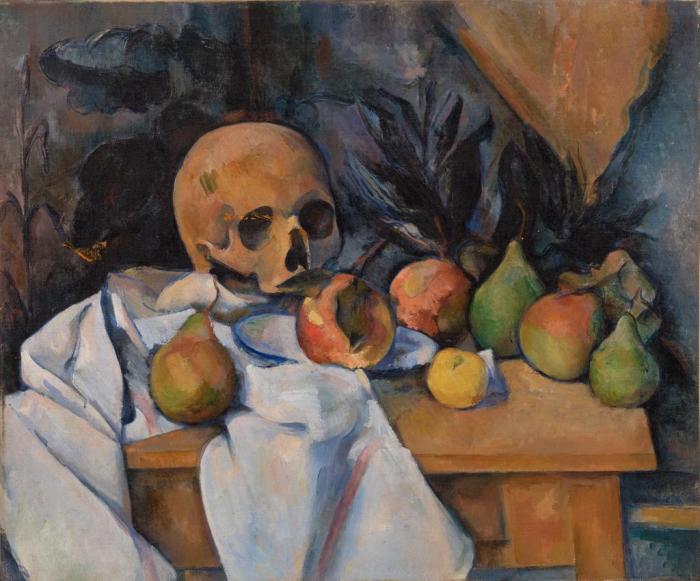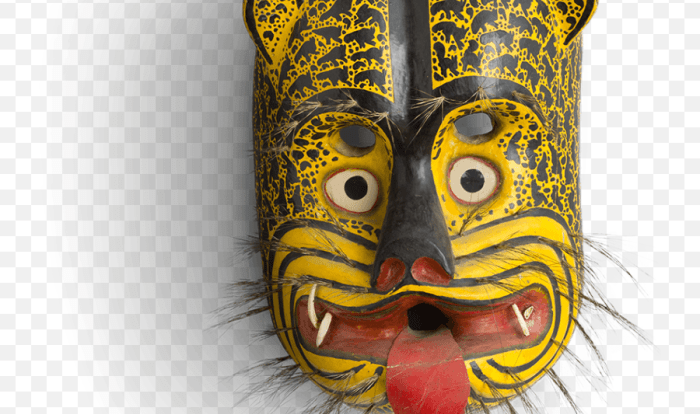Still life with skull cezanne – Cézanne’s Still Life with Skull, an iconic work of art, invites viewers into a realm of symbolism and technical mastery. This profound painting encapsulates the essence of Cézanne’s unique style and artistic vision.
Through a meticulous analysis of its composition, symbolism, and technique, this exploration unveils the layers of meaning embedded within this captivating masterpiece.
Historical Context: Still Life With Skull Cezanne
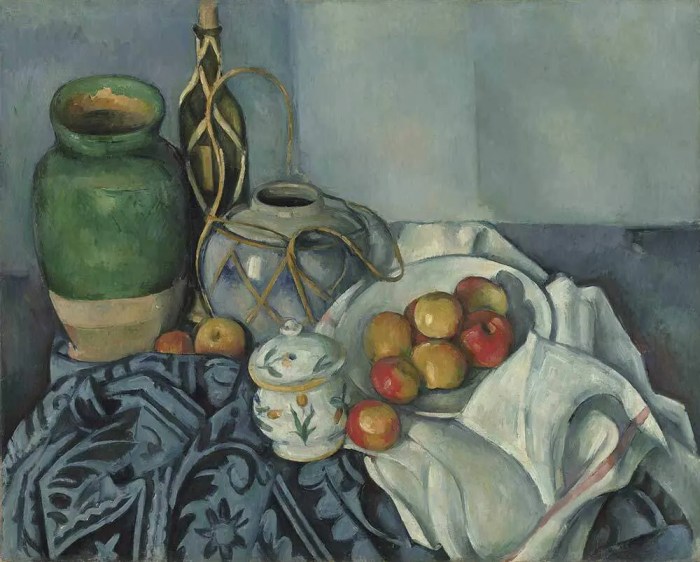
Cézanne’s “Still Life with Skull” was created in 1895-1898, during a period of significant artistic and cultural change. The late 19th century witnessed the rise of modernism, with artists challenging traditional forms and experimenting with new styles and techniques.
Artistic Influences
- Post-Impressionism:Cézanne was influenced by the Post-Impressionists, who sought to move beyond Impressionism’s focus on capturing fleeting moments, instead emphasizing structure and form.
- Cubism:“Still Life with Skull” exhibits elements of Cubism, with its geometric shapes and fragmented forms.
Cultural Influences
- Symbolism:The skull, a common symbol of mortality, reflects the Symbolist movement’s interest in exploring hidden meanings and subjective experiences.
- Fin-de-siècle:The late 19th century was marked by a sense of anxiety and uncertainty, which is reflected in the somber and introspective nature of “Still Life with Skull.”
Formal Analysis
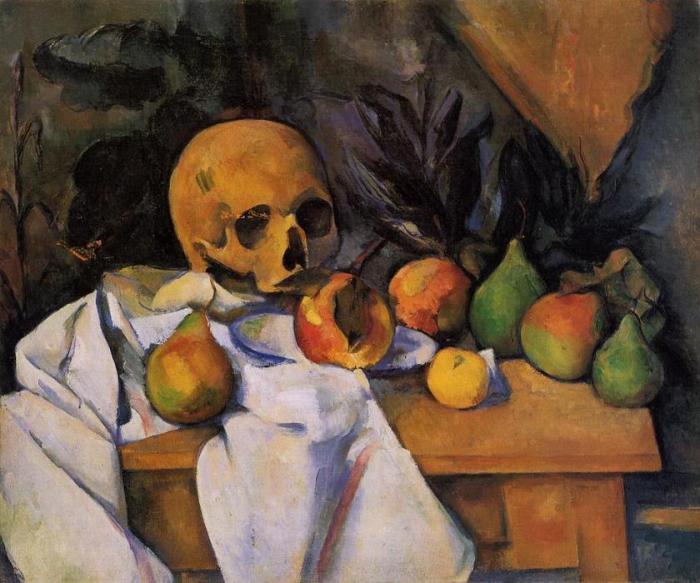
Cézanne’s “Still Life with Skull” exhibits a masterful use of composition, color, line, and shape to create a visually striking and thought-provoking work of art. The arrangement of the objects within the painting is carefully considered, with each element contributing to the overall balance and harmony of the composition.
Color
Cézanne employs a limited palette of warm and cool colors, with shades of brown, green, and blue dominating the composition. The warm tones of the skull and the tablecloth create a sense of intimacy and warmth, while the cooler blues and greens of the background and the drapery provide a sense of depth and recession.
The juxtaposition of these contrasting colors creates a dynamic tension that draws the viewer’s eye throughout the painting.
Line
Cézanne uses strong, geometric lines to define the forms of the objects in the painting. The vertical lines of the skull and the drapery create a sense of stability and order, while the horizontal lines of the table and the background provide a sense of balance and structure.
The interplay of these lines creates a dynamic composition that guides the viewer’s gaze across the canvas.
Shape
The objects in “Still Life with Skull” are rendered in simple, geometric shapes, such as circles, squares, and rectangles. The skull, the most prominent object in the painting, is depicted as a perfect sphere, emphasizing its symbolic significance as a representation of mortality.
The cylindrical shape of the pitcher and the rectangular shape of the table further reinforce the sense of geometric order and simplicity in the composition.
Perspective and Depth
Cézanne uses a combination of linear perspective and atmospheric perspective to create a sense of space and volume in the painting. The objects in the foreground are depicted larger and more detailed than those in the background, creating a sense of depth.
The use of atmospheric perspective, with the colors and values of the objects in the background becoming lighter and less distinct, further enhances the illusion of depth and recession.
Arrangement and Placement
The objects in “Still Life with Skull” are arranged in a carefully balanced and asymmetrical composition. The skull is placed in the center of the canvas, commanding the viewer’s attention. The pitcher and the drapery are placed to the left and right of the skull, respectively, creating a sense of equilibrium and stability.
The empty space around the objects emphasizes their isolation and the sense of solitude and contemplation that pervades the painting.
Symbolism and Meaning
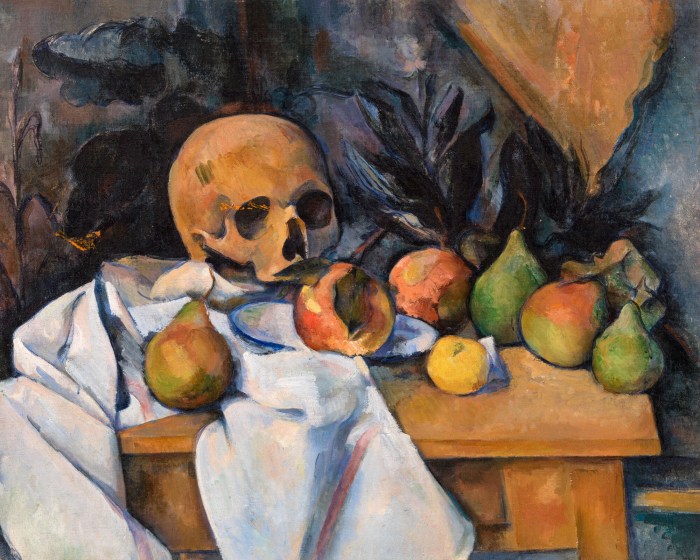
The objects in “Still Life with Skull” carry profound symbolic meanings that contribute to the painting’s philosophical and existential themes. The skull, fruit, and tablecloth each hold significant cultural and personal associations, inviting viewers to contemplate the nature of life, death, and the human condition.
The Skull
The skull is a ubiquitous symbol of mortality and the transience of life. In Western art, it often represents the memento mori, a reminder of the inevitability of death and the need to live life to the fullest. In “Still Life with Skull,” the skull’s placement at the center of the composition draws attention to its central role in the painting’s message.
The Fruit
The fruit in the painting symbolizes abundance, fertility, and the beauty of nature. However, it also serves as a reminder of the fleeting nature of life and the inevitability of decay. The fruit’s vibrant colors and textures contrast with the skull’s pale, bony surface, highlighting the cycle of life and death.
The Tablecloth
The tablecloth in the painting is a symbol of domesticity and comfort. It represents the familiar and the mundane, in contrast to the skull’s reminder of mortality. The tablecloth’s folds and creases add a sense of movement and depth to the composition, creating a visual tension that reflects the painting’s exploration of life’s contradictions.
Philosophical and Existential Themes
Through its symbolism, “Still Life with Skull” conveys a range of philosophical and existential themes. The painting encourages viewers to contemplate the nature of life and death, the beauty of the natural world, and the fleeting nature of existence. It invites us to reflect on our own mortality and to appreciate the preciousness of life.
Technique and Style
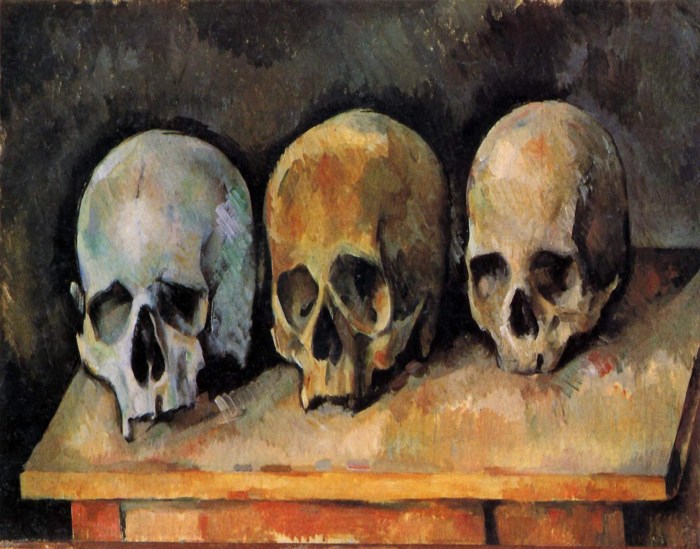
Cézanne’s unique painting style, characterized by its geometric forms, rich color palette, and impasto brushwork, revolutionized still life painting.
He utilized bold, simplified shapes to depict objects, creating a sense of solidity and volume. His use of color was vibrant and expressive, with warm and cool tones juxtaposed to create contrast and depth. Cézanne’s impasto technique, where thick layers of paint were applied, added texture and a tactile quality to his paintings, further enhancing the illusion of three-dimensionality.
Color and Form
Cézanne’s color palette was characterized by its richness and intensity. He often used complementary colors, such as red and green, to create contrast and visual interest. He also experimented with color theory, juxtaposing warm and cool colors to create a sense of depth and atmosphere.
Still life with skull by Cezanne is a painting that depicts a simple arrangement of objects on a table. The painting is known for its muted colors and its use of geometric shapes. The painting is also a good example of Cezanne’s interest in the relationship between objects and space.
Chapter 10 mendel and meiosis explains the process of cell division that produces gametes, or sex cells. The process of meiosis is essential for sexual reproduction. Still life with skull by Cezanne is a painting that is both visually appealing and thought-provoking.
Cézanne’s approach to form was equally innovative. He simplified objects into geometric shapes, such as cubes, spheres, and cylinders. This geometric reduction allowed him to focus on the essential qualities of the objects, creating a sense of order and stability.
Brushwork and Impasto
Cézanne’s brushwork was deliberate and controlled, with visible brushstrokes that added texture and movement to his paintings. He often used impasto, applying thick layers of paint to create a sense of depth and tactility. This technique allowed him to build up forms gradually, creating a rich and complex surface.
Comparison to Other Artists
Cézanne’s approach to still life painting differed significantly from that of his contemporaries. Unlike the Impressionists, who focused on capturing the fleeting effects of light and atmosphere, Cézanne sought to depict the underlying structure and solidity of objects. His work also differed from the Academic tradition, which emphasized smooth, polished surfaces and idealized forms.
Influence and Legacy
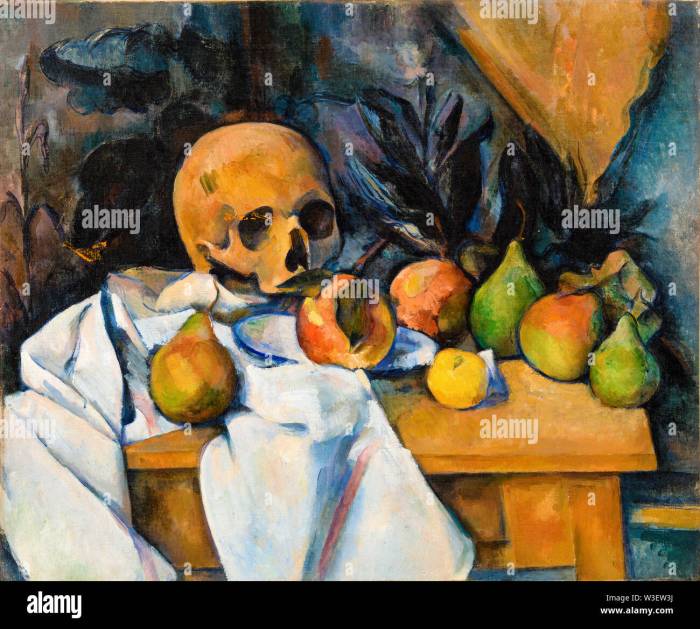
Cézanne’s “Still Life with Skull” profoundly influenced the development of modern art, particularly in the realms of Cubism and abstraction.
The painting’s innovative use of perspective, simplified forms, and muted colors laid the groundwork for Cubism, as exemplified in the works of Picasso and Braque.
Development in Later Artists, Still life with skull cezanne
Cézanne’s ideas and techniques were further developed by later artists, including:
- Henri Matisse: Matisse’s use of flat colors and simplified forms in his paintings was directly influenced by Cézanne’s work.
- Pablo Picasso: Picasso’s early Cubist paintings, such as “Les Demoiselles d’Avignon,” show a clear debt to Cézanne’s fragmented and geometric compositions.
- Georges Braque: Braque collaborated with Picasso to develop Cubism, and his paintings often featured the same simplified forms and muted colors found in Cézanne’s work.
Significance in Art History
“Still Life with Skull” is considered a pivotal work in the history of art, as it represents a significant departure from traditional representational painting and paved the way for the development of modernism.
Question Bank
What is the significance of the skull in the painting?
The skull serves as a potent symbol of mortality and the transience of life, contrasting with the vibrant fruit, representing the fleeting nature of earthly pleasures.
How does Cézanne’s use of color contribute to the painting’s impact?
Cézanne’s masterful use of muted and earthy tones creates a sense of depth and volume, drawing the viewer’s attention to the interplay of objects and their relationship to the surrounding space.
